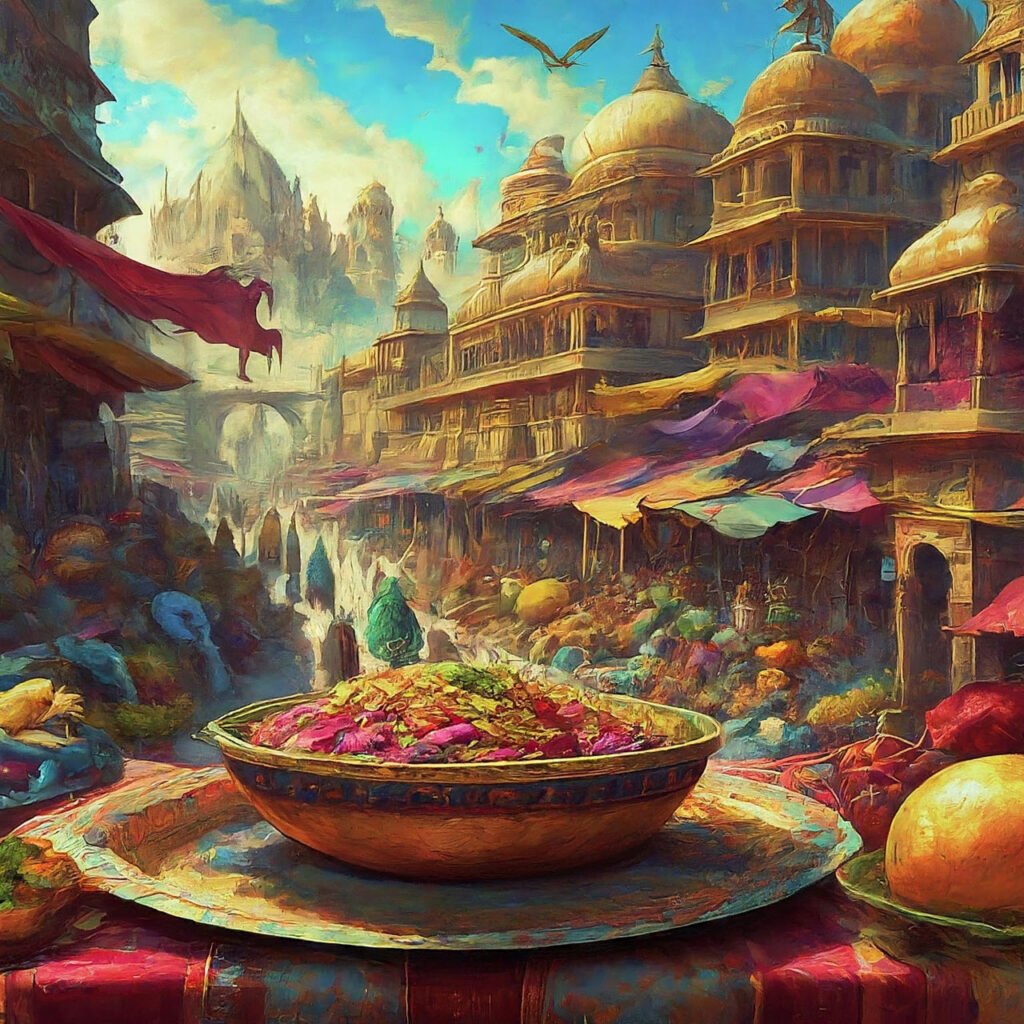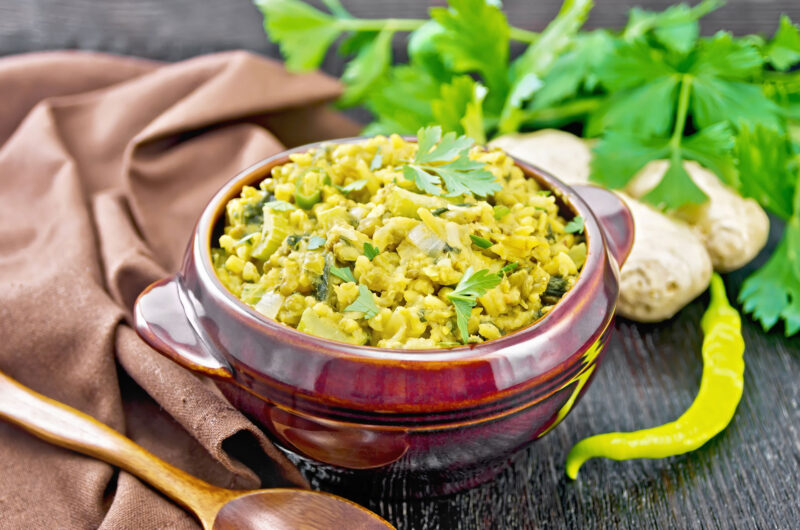Introduction
Did you know there’s a simple dish that can detoxify your body and improve gut health? Meet Kitchari – a traditional Ayurvedic meal that has been cherished for centuries for its healing properties.
A blend of basmati rice and mung beans with the consistency of Risotto, Kitchari is more than just comfort food. This nutritious dish is renowned in Ayurveda for its ability to detoxify the body, support gut health, and provide easy digestion. Often considered a staple during cleansing periods, Kitchari is gentle on the stomach yet packed with essential nutrients.
Coming up, we’ll explore the rich history and cultural roots of Kitchari, delve into the basics of Ayurveda and its body types, and uncover the myriad of health benefits this humble dish offers.
Plus, we’ll share a simple Kitchari recipe so you can experience the healing power yourself!
History and Cultural Roots of Kitchari
The Tale of King Rajiv and the Healing Kitchari

In the ancient kingdom of Ayurajya, ruled by King Rajiv, there lived a wise sage named Amrita. One day, a mysterious illness plagued the kingdom, affecting both the rich and the poor. Queen Surya fell gravely ill, and all remedies seemed futile.
Desperate for a cure, King Rajiv sought out Sage Amrita for guidance. Sage Amrita, known for his profound knowledge of Ayurveda, prescribed a special healing dish called Kitchari to restore balance and vitality. Kitchari is a nourishing blend of rice and lentils, often seasoned with spices like turmeric and cumin. This simple yet powerful dish is easy to digest and helps cleanse the body, supports digestion, and strengthens the immune system.
Made with love and intention, Kitchari was believed to hold the key to unlocking the body’s innate healing abilities. Infused with healing spices that pull toxins out of the body, reduce inflammation and stimulate digestive fire, Sage Amrita embued the food with prayers for the queen’s swift recovery.
Queen Surya’s health began to improve steadily after consuming the healing Kitchari. The kingdom rejoiced as she emerged strong and radiant, her vitality restored by the nourishing embrace of this ancient dish.
As the kingdom embraced the nourishing qualities of Kitchari, miraculous recoveries began to unfold. Stories emerged of villagers regaining their health, strength returning to the weak, and hope blooming once more in the hearts of the afflicted.
From that day forth, Kitchari became a symbol of healing and hope in Ayurajya. King Rajiv decreed that Kitchari would be shared with all in need, ensuring that its transformative power could reach every corner of the realm. The legend of King Rajiv and the healing Kitchari lives on as a testament to the profound wisdom of Ayurveda and the miraculous potential of this humble dish to bring restoration and well-being to all who partake.
The True Kitchari Story!
As you may have realized, the legend of King Rajiv and his court, while amazing, is a work of fiction. But something similar might have happened!
Here is what we know for sure about Kitchari’s cultural roots…
Kitchari, often referred to as “the food of the gods,” has a history that dates back thousands of years. This dish holds a special place in Ayurvedic tradition and is believed to have originated in ancient India.
In Sanskrit, “Kitchari” means a mixture, typically of rice and mung beans. It has been a staple in Indian households not only for its simplicity but also for its profound health benefits. Traditionally, it is used during periods of cleansing and healing, serving as a gentle yet nourishing meal that supports the body’s natural detoxification processes.
Kitchari’s appeal extends beyond India. In various cultures, similar dishes can be found, each with its own unique twist. For example, in some regions of South Asia, different spices and vegetables are added to enhance the flavor and nutritional profile. Despite these variations, the core components remain the same: a combination of grains and legumes that provide complete protein and balanced nutrition.
Over time, Kitchari has gained recognition worldwide, especially among people seeking holistic health solutions. Its simplicity and effectiveness make it an ideal choice for anyone looking to incorporate traditional healing foods into their modern lifestyle.
Understanding Ayurveda
Ayurveda, often referred to as the “science of life,” is a holistic healing system that originated in India over 5,000 years ago. It focuses on maintaining balance and harmony within the body, mind, and spirit to promote overall health and well-being.
At the heart of Ayurveda are the three Doshas: Vata, Pitta, and Kapha. These Doshas represent different combinations of the five elements (earth, water, fire, air, and ether) and govern various physiological and psychological functions in the body. Each person has a unique constitution or Prakriti, which is a specific balance of these Doshas.
Vata: Composed of air and ether, Vata is responsible for movement, including breathing, circulation, and nerve impulses. Individuals with a predominant Vata Dosha tend to be energetic, creative, and quick-thinking but may also experience anxiety and digestive issues when imbalanced.
Pitta: Made up of fire and water, Pitta governs digestion, metabolism, and energy production. Those with a dominant Pitta Dosha are often intelligent, driven, and strong-willed but can suffer from inflammation, irritability, and digestive disorders when out of balance.
Kapha: Consisting of earth and water, Kapha controls growth, structure, and lubrication in the body. People with a primary Kapha Dosha are typically calm, patient, and nurturing but may struggle with weight gain, lethargy, and congestion when imbalanced.
Wondering what your primary Dosha might be? Try a quiz to discover more about your unique constitution and Dosha balance.
Ayurveda emphasizes the importance of a balanced diet, lifestyle, and mental state to maintain harmony among the Doshas. Kitchari plays a vital role in this system as it is considered tri-doshic – meaning it can help balance all three Doshas – making it an ideal food for cleansing and healing.
The Healing Benefits of Kitchari
Kitchari offers a myriad of health benefits that contribute to overall well-being. This simple yet sophisticated blend of rice, mung beans, and spices simmered in ghee is considered a staple for cleansing and nourishing the body.
Kitchari Nutritional Profile
Kitchari is a complete protein source, combining basmati rice and mung beans to provide all essential amino acids. It is rich in fiber, vitamins, and minerals, offering a well-rounded nutritional profile that supports overall health and vitality.
Digestive Support
The gentle nature of Kitchari makes it easy on the digestive system, making it an ideal meal for those with sensitive digestion or during times of cleansing. The warming spices like cumin, coriander, and turmeric aid in digestion and help alleviate digestive discomfort. Ghee is believed to stimulate the digestive fire, known as Agni. It helps in better digestion and absorption of nutrients from the food and adds a rich buttery taste.
Detoxification and Cleansing
As a light and easily digestible meal, Kitchari is often used in Ayurvedic cleanses to support the body’s natural detoxification processes. It helps clear ama (toxins) from the body, rejuvenating the digestive tract and promoting overall wellness.
Balancing the Doshas
Kitchari’s tri-doshic nature makes it an excellent choice for balancing Vata, Pitta, and Kapha Doshas. Its harmonizing qualities help bring equilibrium to the body and mind, supporting optimal health and vitality.
Emotional Well-being
Beyond its physical benefits, Kitchari is also known for its calming and grounding effects on the mind. Enjoying a warm bowl of Kitchari can provide comfort and nourishment, promoting a sense of relaxation and well-being.
Incorporating Kitchari into your diet can be a transformative experience, offering not just physical nourishment but also emotional and spiritual healing. Whether you’re looking to support your digestion, cleanse your body, or simply enjoy a yummy meal, Kitchari is a versatile dish that can nourish you on multiple levels.
Learn How to Make Kitchari
We invite you to try our simple and nourishing Kitchari recipe. This is one I’ve prepared myself multiple times and it always hits the mark! Embrace the soothing flavors and therapeutic qualities of this Ayurvedic staple as you continue on your journey to radiant health.
Traditional Kitchari Recipe
Course: Lunch, DinnerCuisine: Ayurveda, Indian, South AsianDifficulty: Easy4
servings1
hour30
minutesIngredients
1 cup basmati rice (brown or white)
1/2 cup split yellow mung beans (moong dal)
2 tablespoons ghee
1 teaspoon black mustard seeds
1 teaspoon cumin seeds
2 pinches hing (asafetida)
1 stick of kombu (seaweed)
1/2 teaspoon turmeric powder
1 teaspoon fresh grated ginger
5 cups water
1/2 teaspoon sea salt
2 cups of chopped vegetables
Fresh cilantro leaves for garnish
Directions
- Begin by washing the rice and mung beans thoroughly, then soak them in water overnight. After soaking, make sure to drain the water.
- In a saucepan, gently heat the ghee. Add in ground ginger, mustard seeds, cumin seeds, and hing (asafoetida). Sauté the spices for about one to two minutes until the mustard seeds start popping and the aroma of the spices is released.
- Add the soaked rice and mung beans to the pan and sauté for 2-4 minutes or until they begin to stick to the edges of the pan.
- Pour in 5 cups of water and bring the mixture to a boil. Stir in seaweed, salt, and turmeric, then reduce the heat to a simmer. Cover the pan and let it cook until the beans and rice are tender, typically around 30-45 minutes.
- If you plan on adding vegetables to your kitchari, introduce longer-cooking vegetables like carrots and beets halfway through the cooking process. For vegetables that cook faster, such as leafy greens, add them towards the end of the cooking time.
- The ideal consistency for your kitchari should resemble that of a vegetable stew rather than a thin broth.
- Adjust the water level if needed and season with additional salt to taste.
- Serve with a garnish of fresh cilantro or alongside a flavorful chutney (or both).
Notes
- This recipe captures the essence of traditional kitchari preparation and can be easily adapted to suit different tastes and dietary preferences.
- If you need extra flavor you can add a vegetable bouillon cube with the water.

Dr Josse Ford
Josse Ford is the Founder and Director of the Alchemy Radiant Health clinic in Encinitas, California. She specializes in the integration of Chinese medicine and functional medicine to treat the whole human holistically and to focus on the root cause of illness




